
HOME
INTRO
SYMBOLS
ALMANAC
ECONOMY
GEOGRAPHY
STATE MAPS
PEOPLE
FORUM
NEWS
COOL SCHOOLS
STATE QUIZ
STATE LINKS
BOOK STORE
MARKETPLACE
NETSTATE.STORE
NETSTATE.MALL
GUESTBOOK
CONTACT US


Texas State Play
According to the Galveston Daily News, the inspiration for an official state play came after a meeting of the House of Representatives Subcommittee on Tourism. The topic of conversation; the Texas Sesquicentennial Celebration scheduled for 1986 that would mark the 150th anniversary of Texas' independence from Mexico.
On January 9, 1979 Senate Bill No. 93, authored by State Senator A.R. "Babe" Schwartz, was read for the first time.
It proposed that the historical outdoor drama, "The Lone Star," by Pulitzer Prize-winning dramatist Paul Green, be adopted as the official play of the State of Texas. After some minor changes, it was handily approved in the Texas Senate on April 24, 1979.
Schwartz
S.B. 93
A BILL TO BE ENTITLED
AN ACTrelating to an official state play; designating "The Lone Star" outdoor musical drama which is presented annually in the amphitheatre in Galveston Island State Park as an official play of the State of Texas; and declaring an emergency.
BE IT ENACTED BY THE LEGISLATURE OF THE STATE OF TEXAS;
SECTION 1. LEGISLATIVE FINDINGS. The Legislature of the State of Texas finds that:
(a) in 1821, Stephen F. Austin received a grant from Mexico to establish a colony in Texas for 300 families, this quota known as "the Old Three Hundred," with San Felipe de Austin on the Brazos serving as the seat of government; and
(b) in 1833, Stephen F. Austin traveled to Mexico City to present a state constitution and petition for reforms drafted at the Second Convention at San Felipe and was arrested and imprisoned by the Mexican President Santa Anna; and
(c) on March 2, 1836, a convention at Washington-on-the-Brazos declared Texas independent and named David G. Burnet president and Colonel Sam Houston commander-in-chief of the army; and
(d) on March 6, 1836, 187 Texans, commanded by Colonel William B. Travis, were besieged at the Alamo by 4,000 to 5,000 of Santa Anna's Mexican soldiers; and
(e) on April 21, 1836, Sam Houston's army routed the Mexican troops at the junction of the San Jacinto and Buffalo Bayou and captured Santa Anna; and
(f) this historic battle led to the independence of Texas and its later annexation to the United States; and
(g) the Lone Star Historical Drama Association, endorsed by the Daughters of the Republic of Texas and working cooperation with the Texas Parks and Wildlife Department, is proud of this stirring saga of the history of the state an presents an annual outdoor musical drama "The Lone Star" to reenact the founding of the Republic; and
(h) this outstanding moment in the history of our state and our nation as recreated in this annual outdoor drama is worthy of official recognition and encouragement.
SECTION 2. DESIGNATION AS STATE PLAY. The historical outdoor drama by Pulitzer-prize winning playwright Paul Green known as "The Lone Star," presented annually by the citizens of the State of Texas and the City of Galveston, is hereby designated and official play of the State of Texas.
SECTION 3. EMERGENCY. The importance of this legislation and the crowded condition of the calendars in both houses create an emergency and an imperitive public necessity that the constitutional rule requiring bills to be read on three several days in each house be suspended, and the rule is hereby suspended, and that this Act take effect and be in force from and after its passage, and it is so enacted.
When Senate Bill No. 93 moved into the Texas House of Representatives, "The Lone Star" found company. The House Committee on State Affairs decided to embellish the work of Senator Schwartz and composed a substitute bill that included three additional historical plays; the outdoor historical drama, Texas," also by Paul Green; the outdoor historical drama, "Beyond the Sundown," by Kermit Hunter; and the outdoor historical musical, "Fandangle," created by Robert Nail.
By: Schwartz (McLeod) S.B. No. 93
Substitute the following for S.B. No. 93.
By: Grubbs C.C.S.B. No. 93
AN ACT
relating to the designation of official state plays.
BE IT ENACTED BY THE LEGISLATURE OF THE STATE OF TEXAS;
SECTION 1. The legislature finds that:
(1) the historic battles of San Jacinto, Goliad, and the Alamo that led to the independence of Texas are portrayed faithfully and artistically at Galveston Island State Park in the play, The Lone Star;
(2) the lives of early settlers of the Panhandle of Texas are portrayed colorfully and creatively each year at the Palo Duro Canyon State Park in the play, Texas;
(3) the relationship between early settlers of East Texas, especially General Sam Houston and the Alabama-Coushatta Indians, is portrayed historically and excitingly at the Alabama-Coushatta Indian Reservation in the play Beyond the Sundown; and
(4) the founding of Fort Griffin and the lived of the settlers of Shackleford County and Albany, Texas, during the 1870s and 1880s are depicted during the last two weeks in June annually in Shackleford County in the play Fandangle.
SECTION 2. The Lone Star, presented in Galveston Island State Park, Texas presented in Palo Duro Canyon State Park, Beyond the Sundown, presented at the Alabama-Coushatta Indian Reservation, and Fandangle, presented in Shackleford County, are designated official plays of the State of Texas.
SECTION 3. The importance of this legislation and the crowded condition of the calendars in both houses create and emergency and an imperative public necessity that the constitutional rule requiring bills to be read on three several days in each house be suspended, and the rule is hereby suspended, and that this Act tack effect and be in force from and after its passage, and it is so enacted.

"Texas: A Symphonic Outdoor Drama of American Life"
The House substitute was approved by the Senate on May 25, 1979.
"Texas," by Paul Green, was declared one of four official plays of the State of Texas when Governor William P. Clements signed Senate Bill No. 93 into law on June 6, 1979.
An idea born in 1960
Margaret Pease Harper, considered the founder of the outdoor historical drama "Texas," was born in St. Paul, Minnesota but came to live in Canyon, Texas when her husband Ples accepted a job with West Texas State Teachers College in 1946. Ensconced in Canyon, Mrs. Harper resumed a career as a piano teacher.
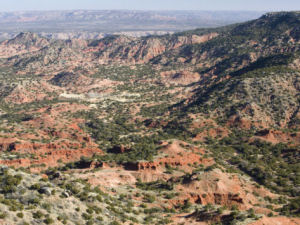
Palo Duro Canyon
Photographs, prints, posters
In July, 1960 Ples and Margaret Harper were having dinner with William and Margaret Moore.
Discussion turned to Palo Duro Canyon, a gem of the Texas Panhandle, and little known to the greater world. They talked about the canyon’s attributes, its history, and the beautiful sunsets that highlighted the red cliffs rising from the valley.
Thoughts of the economic woes of Canyon when the college closed at the end of spring semester, the resulting population drop, and a July 1960 article in the Reader’s Digest about Pulitzer Prize-winning dramatist Paul Green mingled with genuine adoration for Palo Duro Canyon. These thoughts combined to form the germ of an idea for what would ultimately result in the construction of an outdoor amphitheater in Palo Duro Canyon. In that amphitheater they determined to stage a symphonic drama by North Carolinian Paul Green.
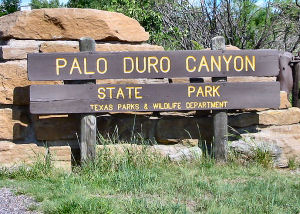
Palo Duro Canyon State Park
Photographs, prints, posters
Mrs. Harper's background in music and her belief that the arts were an important part of society and should be shared by everyone allowed her to visualize such an outdoor historical production in Palo Duro Canyon.
The group was intrigued with the work of Mr. Green who, at the time, had been writing plays for 40 years, many of them historical dramatizations. His most recent works at the time were; "The Stephen Foster Story," produced by the Stephen Foster Drama Association and opening at the J. Dan Talbott Amphitheatre in Bardstown, Ky. on June 26, 1959; "The Confederacy," produced by the Tidewater Historic Drama Association and opening at the Robert E. Lee Amphitheatre in Virginia Beach, Va. on July 1, 1958; and "The Founders," produced by the Jamestown Corporation and opening at the Cove Amphitheatre in Jamestown, Va. on May 13, 1957.
The July dinner discussion resulted in a commitment by Mrs. Harper to contact Mr. Green. She wrote to him, extolling the geography, the people and the history of the Texas Panhandle. She also mentioned that Palo Duro Canyon would make an ideal setting for an outdoor historical drama centered on the culture and history of the panhandle. She asked him if such a production would interest him.
It did.
Mrs. Harper began promoting the ideas to friends and colleagues. This lead to the formation of the Texas Panhandle Heritage Foundation (chartered, autumn 1961), of which Margaret Harper was the first president.
Naively hoping to produce a first production in the canyon in 1962, fund-raising commenced.
In the meantime, William and Margaret Moore embarked on a 30-day, 7,000 mile fact-finding mission. They visited areas where symphonic dramas were being produced, attending nine shows.
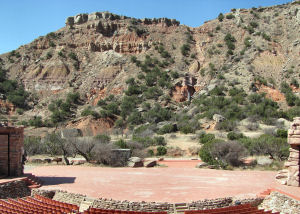
Before the fun begins
Raising the necessary funds did not proceed at the pace the foundation would have liked and compromises had to be made along the way, but Margaret Harper and the Texas Panhandle Heritage Foundation did not give up hope.
Paul Green’s "Texas" opened in the amphitheater in Palo Duro Canyon on July 1, 1966. Since then, millions from around the world have come to see the show.
"In this family-friendly show set against an authentic tapestry of history, the show’s fictional characters bring to life the stories, struggles and triumphs of the settlers of the Texas Panhandle in the 1800s. Song and dance abound-and a generous helping of good ol’ Texas humor too-with spellbinding lighting, special fire and water effects, including the Dancing Waters of TEXAS! (fireworks are also included nightly when conditions allow)"
(Texas Show)
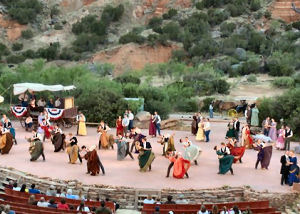
"Song and dance abound"
This historical symphonic drama, "Texas," by Paul Green is presented by the Texas Panhandle Heritage Foundation at the Pioneer Amphitheater in Palo Duro Canyon, Canyon.
Get tickets for summer production!
Texas Law
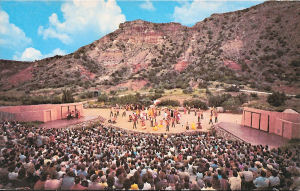
Postcard: Palo Duro Canyon State Park provides a matchless
western setting for Pioneer Amphitheatre and
Paul Green's musical drama "TEXAS."
Bill Rhew Photography
The following information was excerpted from the Texas Statutes: Government Code, Title 11, Subtitle A, Chapter 3101, Section 3101.011.
TITLE 11. STATE SYMBOLS AND HONORS; PRESERVATION
SUBTITLE A. STATE SYMBOLS AND HONORS
CHAPTER 3101. STATE SYMBOLS
Sec. 3101.011. STATE PLAYS.
Sec. 3101.009. STATE PLAYS. The following plays are official state plays of Texas:
(1) The Lone Star presented in Galveston Island State Park;
(2) Texas presented in the Palo Duro Canyon State Park;
(3) Beyond the Sundown presented at the Alabama-Coushatta Indian Reservation; and
(4) Fandangle presented in Shackelford County.
Added by Acts 2001, 77th Leg., ch. 1420, Sec. 7.001, eff. Sept. 1, 2001.
Sources...
"House Bill No. 2812." The Legislature of the State of Texas. The State of Texas, 2005. Web. 27 Sep 2011.
"We invite you all to come to TEXAS!." Texas Show. The Texas Panhandle Heritage Foundation, n.d. Web. 25 Jan 2012.
"Outdoor drama finds renewed life in canyon." Amarillo Globe-News. Amarillo Globe-News, 01 Jun 2006. Web. 25 Jan 2012.
Guy, Duane F., Editor. The Story of Palo Duro Canyon. Classic Reissues of the American West. Lubbock: Texas Tech University Press, 2001. 182. Print.
"Texas Constitution and Statutes." The Legislative Reference Library of Texas. The State of Texas, 27 Sep 2011. Web. 27 Sep 2011.
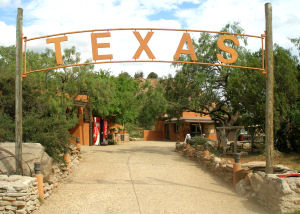
Welcome to "Texas," an official play of the State of Texas
Additional Information
"Texas" the Musical Drama: Lost Planet Media: Texas Less Traveled.
Visiting Texas: By the Texas Panhandle Heritage Foundation.
Palo Duro Canyon State Park: Palo Duro Canyon State Park from the Texas Parks and Wildlife Department.
Palo Duro Canyon: The Handbook of Texas Online; The Texas State Historical Association.
Palo Duro Canyon State Scenic Park: The Handbook of Texas Online; The Texas State Historical Association.
The Texas Panhandle Heritage Foundation: The Handbook of Texas Online; The Texas State Historical Association.
Harper, Margaret Pease: Inducted 1988; Texas Woman's University: Texas Women's Hall of Fame.
Margaret Pease Harper: Texas State Historical Association: The Handbook of Texas Online.
Margaret Pease Harper: 1981 Cowgirl Honoree; Texas - National Cowgirl Museum and Hall of Fame .
Margaret Harper: May 19, 2000 article by Shanna Foust-Peeples, Amarillo Globe News.
Paul Green: Dramatist and Activist: Official website maintained by the Paul Green Foundation.
Other official plays of the State of Texas:
More symbols & emblems: Complete list of official Texas state symbols from NETSTATE.COM.
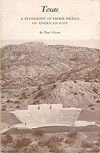
Texas
Paul Green
Texas: A Symphonic Outdoor Drama of American Life, by Paul Green. 104 pages. Publisher: Samuel French (1967) The story of ranchers and farmers in West Texas and their struggle to wrest a living from the land of America's last frontier.
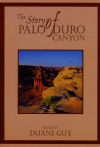
The Story of
Palo Duro Canyon
The Story of Palo Duro Canyon, Edited by Duane Guy. 240 pages. Publisher: Texas Tech University Press (May 15, 2001) Of the canyons that break the eastern edge of the Staked Plains, Palo Duro is by far the most spectacular. As one approaches the edge, the earth opens up into a vast gash, a geological and ecological wonder. And whether you come to Palo Duro as a novice or veteran canyoneer, the thrill and the mystery are always intense. How did the canyon get here? What caused the vari-color of the walls and formations? Why do some formations stand completely separated from the canyon walls? Did the little stream running along the canyon floor form this canyon all by itself? Who were the first people to find this canyon and how did they react?
Originally published as an edition of the Panhandle Plains Historical Review, The Story of Palo Duro Canyon, with its seven essays devoted to geology, archeology, paleontology, vegetation, park development, and the amphitheater, and its road log from Canyon, Texas, through the Palo Duro State Park, has become a classic.

Branding Texas
Leigh Clemons
Branding Texas: Performing Culture in the Lone Star State, by Leigh Clemons. 202 pages. Publisher: University of Texas Press (August 15, 2008) Ask anyone to name an archetypal Texan, and you're likely to get a larger-than-life character from film or television (say John Wayne's Davy Crockett or J. R. Ewing of TV's Dallas) or a politician with that certain swagger (think LBJ or George W. Bush). That all of these figures are white and male and bursting with self-confidence is no accident, asserts Leigh Clemons. In this thoughtful study of what makes a "Texan," she reveals how Texan identity grew out of the history—and, even more, the myth—of the heroic deeds performed by Anglo men during the Texas Revolution and the years of the Republic and how this identity is constructed and maintained by theatre and other representational practices.
Clemons looks at a wide range of venues in which "Texanness" is performed, including historic sites such as the Alamo, the battlefield at Goliad, and the San Jacinto Monument; museums such as the Bob Bullock Texas State History Museum; seasonal outdoor dramas such as Texas! at Palo Duro Canyon; films such as John Wayne's The Alamo and the IMAX's Alamo: The Price of Freedom; plays and TV shows such as the Tuna trilogy, Dallas, and King of the Hill; and the Cavalcade of Texas performance at the 1936 Texas Centennial. She persuasively demonstrates that these performances have created a Texan identity that has become a brand, a commodity that can be sold to the public and even manipulated for political purposes.

